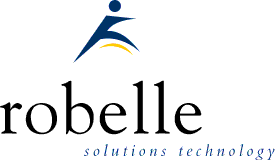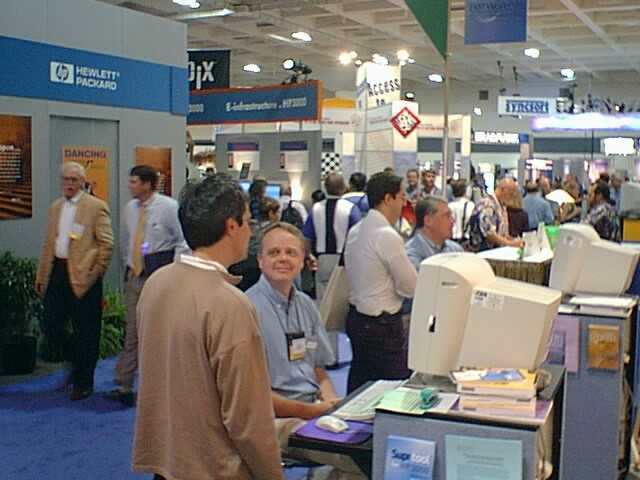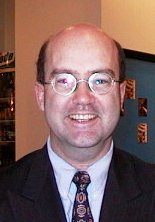What's Up, DOCumentation? 1999 # 4

September 1999
From:
- Robert M. Green, President
- David J. Greer, Vice President
- Paul Gobes, Editor pro tem
To: Users of Robelle Software
Re: News of the HP 3000 and of HP-UX, 1999 #4
What You Will Find in This News Memo:
- Robelle at HP World '99
- And the Winner Is ...
- Robelle Celebrates with Interex
- Suprtool Training
- Early Access to MPE/iX 6.5
- An Australian Revisits Robelle
- Staff Spotlight: Robyn Rennie
- POSIX Work Made Easy with Qedit
- Firewall Support Fails in MPE/iX 4.0
- New Column Editing in Qedit for Windows
- New $Days Function Creates ASK Dates
- Year 2000 Compliant Versions
- Attention PowerHouse Users
- Y2K Tip: Shorter Date-Creating Command File
- Converting Copylib Members to Individual Files
Robelle at HP World '99
At HP World '99 in San Francisco's Moscone Center this year, Hewlett-Packard's presentations and press releases highlighted E-services, and "E-words" were prominent everywhere. New at the vendor show was a large booth promoting 3kworld (http://www.3kworld.com/), a venture aimed at providing a central Web resource that links users as well as hardware and software vendors, and provides a newsroom, event center, message boards, chat rooms, etc.
 At Robelle's booth we presented short tutorials showcasing new features in
our products. David Greer's presentation on Qedit for Windows' new scripting
language was so popular that he had to deliver a few more unscheduled talks.
Bob Green gave a short course on Regular Expressions (now available in both
Qedit and Qedit for Windows), and other tutorials demonstrated Suprtool's
ability to serve data to the Web. Visitors also received our way cool
collector's item: a black HP World '99 Robelle t-shirt.
[photo]
At Robelle's booth we presented short tutorials showcasing new features in
our products. David Greer's presentation on Qedit for Windows' new scripting
language was so popular that he had to deliver a few more unscheduled talks.
Bob Green gave a short course on Regular Expressions (now available in both
Qedit and Qedit for Windows), and other tutorials demonstrated Suprtool's
ability to serve data to the Web. Visitors also received our way cool
collector's item: a black HP World '99 Robelle t-shirt.
[photo]
If you dropped by our booth this year, thank you for visiting. If not, we hope to see you in Philadelphia next year!
[Hans Hendriks]
Up to Table of Contents
And the Winner Is ...
The winners of this year's prizes at Robelle's HP World '99 booth are:
Pedro Gonzalez of Dr. Leonard's Healthcare Corp. (Dragon Naturally Speaking Mobile software) [photo]
Jeff Meissner of The Blood Center of Southeastern Wisconsin (Canon color scanner) [photo]
Michael Gassaway of Baltimore Gas & Electric (PrintMaster Platinum software) [photo]
Congratulations to all of our winners and to everyone who participated in this year's contest.
[Marie Reimer]
Up to Table of Contents
Robelle Celebrates with Interex
The HP 3000 users first organized themselves into a group 25 years ago in 1974. At this year's HP World Conference in San Francisco, Interex celebrated this milestone at a Volunteer Anniversary Lunch for people who have been involved with the users group. Even Doug Meecham, the original spark plug that organized the group and became its first Chairman, attended the lunch and said a few words.
In 1974, that first meeting of users in Palo Alto included 26 users who represented 22 companies from three countries. Robelle's founder, Bob Green, was present as an HP employee and gave a presentation. When the first vendor exhibit started in 1977 at the users meeting in Issaquah, Washington, it was held at a failed nunnery where the five vendors were supplied with card tables for $25 each. Robelle was present, selling its brand new product Qedit. (There's no record of what became of the failed nuns.)
At the first International conference in Lyon, France in 1979, Robelle was present as speaker, vendor, user, and in search of European representatives for Qedit. (It was at this meeting that we met ARES, our first and only distributor in France.) As Interex continued to grow, the annual meeting attendance grew into the thousands. Ten years ago in San Francisco, Interex celebrated its 15-year anniversary and HP their 50th. Robelle was there again and hired a Hornblower yacht to take 300 users on an elegant evening cruise of the bay.
This summer's meeting and 25th Anniversary Lunch was a chance for the founders of the users group to get together and see how Interex has grown over the years, while the HP 3000 has remained a premier computing platform. Robelle's CEO, Bob Green, emerged as the person with the earliest HP experience: as a teenager, Bob took a summer job at Hewlett-Packard in 1967 when the software department consisted of less than 10 people.
Up to Table of Contents
 Suprtool Training
Suprtool Training
In my years of doing Robelle technical support and leading Suprtool classes, I have found that many Suprtool users start out learning just enough to get by, never really becoming acquainted with the newer features and capabilities of new versions. The feedback I've received, from even experienced users, shows that everyone who takes the class learns something new that makes the two-day class worthwhile.
Our authorized consultants offer Suprtool classes in the U.S.:
Paul Edwards
Phone: (972) 242-6660
E-mail: pedwards@gte.netJeff Kubler
Phone: (541) 745-7457
E-mail: jrkubler@proaxis.com
For training in other regions, please contact your local Robelle distributor or send e-mail to training@robelle.com.
[Mike Shumko]
Up to Table of Contents
 Early Access to MPE/iX 6.5
Early Access to MPE/iX 6.5
At HP World, announcements were made by the CSY division of HP (the people responsible for the HP 3000) about MPE/iX 6.5. This upcoming operating system release increases many of the limits in existing versions of MPE/iX. One of the most important limits involves increasing the maximum size of a file from 4 GB to 128 GB.
While IMAGE/SQL has been enhanced over the last several years to have a maximum dataset size of up to 80 GB, MPE itself still limits files to 4 GB in size. As more users create datasets much larger than 4 GB, it is becoming harder for users to live with the 4-GB file size limit. In MPE/iX 6.5, extensive changes have been made to MPE in order to support files greater than 4 GB. These internal changes to MPE/iX have a significant impact on Suprtool.
To ensure that Suprtool will work with MPE/iX 6.5 and with files greater than 4 GB, special arrangements were made for Neil Armstrong and me to visit CSY in July. Craig Fairchild, senior file system architect at CSY, was our host. He has been one of the key designers in making core changes inside MPE/iX so that files greater than 4 GB can be supported. While we were working with an early build of MPE/iX 6.5, reliability was good -- on files both smaller and larger than 4 GB.
One of the major problems with the changes to MPE/iX 6.5 is designing, developing, and executing test cases. We had access to a high-end HP 3000 with multi-way processes and approximately 55 GB of disc space. While we were the only users on this machine, it still took a long time to create our test data, even though we were focusing on relatively small files of 4.1 and 8.3 GB. With test files of 8.3 GB, we found that we could run out of disc space quickly. For example, a Suprtool test that reads and sorts an 8.3-GB file requires 24.9 GB of disc space (8.3-GB input file, 8.3-GB scratch file, and 8.3-GB output file).
We enjoyed our visit to CSY (we even had time to visit with many well-known HP 3000 technical experts, such as CI Architect Jeff Vance). We appreciated CSY making many resources available to us and giving us early access to MPE/iX 6.5. We are confident that when MPE/iX 6.5 is ready for you to install, Suprtool will also be ready.
[David Greer]
Up to Table of Contents
An Australian Revisits Robelle
In the Canadian summer of 1990, I was fortunate enough to spend three months in the Langley, B.C. office of Robelle. (See article from 1990 newsletter). Then late last year, my new Facilities Management and IT Consulting firm became the Robelle distributor for Australasia.
 I decided it was time to fine tune my technical knowledge of the Robelle
products as well as take a look at how Robelle marketing worked these days. I
wanted to get the message out about how good the Robelle products are to as
many people "downunder" as possible. So, when the literature for HP World '99
in San Francisco came out, I decided I could combine that conference with a
short stay in Vancouver.
I decided it was time to fine tune my technical knowledge of the Robelle
products as well as take a look at how Robelle marketing worked these days. I
wanted to get the message out about how good the Robelle products are to as
many people "downunder" as possible. So, when the literature for HP World '99
in San Francisco came out, I decided I could combine that conference with a
short stay in Vancouver.
By arriving in Los Angeles a couple of days before HP World, I could visit with friends and take in the sights of LA LA Land again. (The highlight was sitting down to a meal at the Typhoon Restaurant at Santa Monica Airport when David Duchovny and his wife, Tea Leoni, walked in. He pestered me for an autograph, but I told him to go away till I finish my Pad Thai Noodles.)
I then moved on to experience a hectic week at HP World '99, basking in the company of Bob Green and David Greer at the Robelle booth. I got to see the Techies Hans Hendriks and François Desrochers as they turned theory into practice in their popular tutorials. The Sales Team of Marie Reimer, Nicky Gunther, and Tammy Roscoe demonstrated their capable sales skills and friendly demeanor as they answered numerous sales queries. Other highlights included playing "dodge the panhandler" whenever I walked anywhere in town, as well as literally bumping into Hewlett-Packard's HP 3000 Chief, Harry Sterling [photo], at the HP Party during an earthquake that registered 5.0 on the Richter Scale. (Sorry Harry. Send the dry cleaning bill to Robelle -- beer washes out easily anyway.)
After the hustle and bustle of the conference, it was great to slip into the more relaxed atmosphere of Vancouver, B.C. Robelle now has a huge expanse of space, compared to the old office in Langley. It is a very comfortable place for the 50% or so Robelle employees that do come to the office each day. As you probably know, the rest work from various parts of Canada, the U.S., and Anguilla (Hi Bob!).
Some things don't change, however. Company-provided lunch is still one of the perks of working, or visiting, Robelle. I stupidly opened my mouth on the first day of my visit, sarcastically asking what day Kraft Macaroni and Cheese was on the menu. Well, this was all the prodding Mike Shumko needed. The menu for Tuesday was -- you guessed it -- Macaroni and Cheese. Thanks Mike. It was quite good, but I won't be too upset if I don't taste it for another nine years.
Whilst the new office is great, I'd have to say that I prefer the old farmhouse in Langley. There was a special feeling about the place and the work environment was unique. What's missing though? Is it the views of the Golden Ears Mountains? Is it the tranquillity of the beautiful farm? Is it that Robelle has grown up into a professionally run company? Is it Frankie the dog knocking over things with his tail? Maybe it's a combination of all of the above.
[Michael Redmond, MRFM Australia] [e-mail]
Up to Table of Contents
Staff Spotlight: Robyn Rennie
 Although Robyn spends most of her time working to develop and maintain our
in-house systems, some of our customers may have spoken to her when she fills
in for our regular technical support staff. Robyn is also one of the hardy
souls who takes a turn on the pager, which provides our 24-hour coverage.
Although Robyn spends most of her time working to develop and maintain our
in-house systems, some of our customers may have spoken to her when she fills
in for our regular technical support staff. Robyn is also one of the hardy
souls who takes a turn on the pager, which provides our 24-hour coverage.
Robyn originally hails from Australia (which explains her accent), but has lived and worked in Canada for 22 years. She first worked with HP MPE systems in the early 80s and has been closely associated with them ever since. She joined Robelle in 1992 and works 3 days a week. The rest of her time is spent keeping up with her family of three boys, camping [photo], cross-country skiing and generally enjoying what British Columbia has to offer.
For a look at other Robelle staff members, check out our company brochure.
[Paul Gobes]
Up to Table of Contents
 POSIX Work Made Easy with Qedit
POSIX Work Made Easy with Qedit
Although POSIX has been around since MPE/iX 4.5, it has been underused so far. That's about to change because new features and applications such as the Apache Web server and Java must reside in the POSIX namespace. The POSIX namespace has its own set of rules, which you should become familiar with. Qedit 4.8 has been enhanced so that it is easier for you to abide by some of these rules.
When you want to access a POSIX file, MPE and most applications require that you prefix the file name with a slash (/) or dot-slash (./). This is easy to forget and can become annoying if you need to use it frequently. To get around this problem, you can now use Set HFS On in Qedit. Once enabled, Qedit automatically inserts a dot-slash prefix in front of file names, if they don't already have a prefix.
Example:
/Text MyFile
Error: NONEXISTENT PERMANENT FILE (FSERR 52)
/Set HFS On
/Text MyFile
4 lines in file
POSIX introduces a new file type called Bytestream. These files have specific attributes, which are slightly different from fixed and variable length files. Qedit automatically recognizes Bytestream files and preserves the file attributes. If you want to create a new Bytestream file, you can use Set Keep Bytestream On before saving the file.
Example:
/Add
I am inserting this text in a new Bytestream file.
//
/Set Keep Bytestream On
/Keep NewByteFile
/Listfile ./NewByteFile,2
PATH= /ACCT/PUB/testdir/
CODE ------LOGICAL RECORD------- -----SPACE----- FILENAME
SIZE TYP EOF LIMIT R/B SECTORS #X MX
1B BA 59 2147483647 1 16 1 32 NewByteFile
POSIX names can have up to 254 characters and can include mixed case letters as well as special characters. Some of these special characters are normally interpreted as string delimiters in Qedit. To avoid conflicts, you can use Set Stringdelimiters to reduce the number of valid delimiters.
Example:
/Verify Stringdelimiters {default delimiters}
Set STRINGDelimiters "|\~{}[]_@?!#>%&:'"
/Set Stringdelimiters Posix {"Posix" can be replaced with own list}
/Verify Stringdelimiters
Set STRINGDelimiters "\:"
As you can see in the example above, you have to use the MPE Listfile command to look at POSIX objects (files and directories). You can use Qedit's new Set Alias option to create useful shortcuts.
Example:
/Set Alias "dir" to ":listfile ./@,2"
/dir
POSIX is definitely in your future. Qedit is ready to help you deal with this new environment.
[François Desrochers]
Up to Table of Contents
 Firewall Support Fails on MPE/iX 4.0
Firewall Support Fails on MPE/iX 4.0
The Qedit for Windows server with firewall support will not run on MPE i/X 4.0, because certain C-library routines are only available on 5.0 and later.
Users will get the following group of error messages:
UNRESOLVED EXTERNALS: _thd_errno (LDRERR 512)
UNRESOLVED EXTERNALS: _thread_set_error (LDRERR 512)
UNRESOLVED EXTERNALS: thd_lock_lang_mutex (LDRERR 512)
UNRESOLVED EXTERNALS: thd_unlock_lang_mutex (LDRERR 512)
UNABLE TO LOAD PROGRAM TO BE RUN. (CIERR 625)
You could try contacting HP to see if you can get the C libraries from them. But since HP no longer supports MPE/iX 4.0, the libraries may not be available.
[Dave Lo]
Up to Table of Contents
 New Column Editing in Qedit for Windows
New Column Editing in Qedit for Windows
In version 4.8 of Qedit for Windows, Robelle has implemented one of the most popular editing enhancements: column operations.
You can now mark a rectangular selection of text by dragging the mouse over the text while pressing the CONTROL key. With a rectangular selection, you can perform the following operations:
Delete it
Blank it
Search and replace within it
Copy it and then paste the selection as new lines
If you have larger areas of text to work with (e.g., an entire file), you can also perform column editing operations via dialog boxes in the Edit command of the Columns menu. With this style of column operations, you can specify exact column positions by using the first and last column numbers. For example, you can now do the following tasks:
Delete or blank a range of columns
Insert a string starting in a certain column position
Shift lines left or right by a certain number of spaces
[Dave Lo]
Up to Table of Contents
 New $Days Function Creates ASK Dates
New $Days Function Creates ASK Dates
The latest pre-release version of Suprtool has a new conversion routine that converts dates to a Julian date number (where 1 = Jan. 1, 4713 BC). Because ASK dates are also a form of Julian dates (based on Nov. 1, 1971) it is possible to create ASK dates in a couple of steps.
The example below converts a file of ccyymmdd dates to Julian dates, then subtracts the constant between ASK and Julian dates. The third step is just a "proof" step that converts the ASK dates back to ccyymmdd dates to show that they are equal to the original file's dates.
in myfile
def cymd,1,8,display
item cymd,date,ccyymmdd
def juldays,1,4,integer
ext cymd, juldays = $days(cymd)
out myfile2,link,temp
xeq
IN=3, OUT=3. CPU-Sec=1. Wall-Sec=1.
in myfile2
def askdate,1,2,integer
ext askdate = juldays - 2441255
ext cymd, juldays
out myfile3,link,temp
x
IN=3, OUT=3. CPU-Sec=1. Wall-Sec=1.
in myfile3
item askdate,date,ask
def newdate,1,8,display
ext newdate=$stddate(askdate)
ext cymd,juldays,askdate
list standard
x
Jul 29, 1999 9:56 File: MYFILE3 Page 1
NEWDATE CYMD JULDAYS ASKDAT
19990729 19990729 2451389 10134
19730101 19730101 2441684 429
20000101 20000101 2451545 10290
IN=3, OUT=3. CPU-Sec=1. Wall-Sec=1.
[Paul Gobes]
Up to Table of Contents
Year 2000 Compliant Versions
From the Frequently Asked Questions category, "What are the year 2000 compliant versions of your software?"
Qedit/MPE 4.6.02 or later
Qedit/UX 4.7.01 or later
Qedit for Windows 4.7.01 or later
Suprtool/MPE 4.1.01 or later
Suprtool/UX 4.2.01 or later
Xpress 3.1.06 or later
See http://www.robelle.com/year2000 for up-to-date Year 2000 information.
[Mike Shumko]
Up to Table of Contents
 Attention PowerHouse Users
Attention PowerHouse Users
PHDate is a date format used by Cognos' PowerHouse 4GL tools. It is a 2-byte integer field, of which the first 7 bits store the year (values 0-99), the next 4 bits store the month, and the last 5 bits store the day. Suprtool has supported this date format for many years.
The problem is, PHDate is not Y2K compliant.
So in the latest versions of PowerHouse (version 8.19 on MPE/iX) Cognos has extended PHDates to optionally store up to the maximum value in those first seven bits, namely ranging from 0 to 127. This new option can be "activated" in one of two ways:
In PDL, specifying "Date size 8" for the ELEMENT or USAGE
In defined or temporary items, specifying "PHDATE Century Included"
The default remains at the old format (year range 0-99).
Suprtool works with PHDates in two ways:
When creating a constant for selection comparisons:
>item inv-date,date,phdate >if inv-date = $today
When converting PHDate fields into yyyymmdd formats:
>extract new-date = $STDDATE(inv-date)
In both cases, Suprtool needs to "know" whether the field is an old- or new- format PHDate. For example (assuming the system date is in the year 2001),
Should $today resolve the year to 01 or 101?
When converting PHDates to yyyymmdd format via the STDdate function, should the Set Date Cutoff value be applied to determine the century component of the new date? In other words, if Suprtool has a date cutoff set at 20, and finds a PHDate with a year value of 15, should it assume that it should pre-pend a 19 or a 20?
So here's what we've done in the latest pre-release of Suprtool:
PHDate in the Item command by default will still mean the "old" PHDate date format (year values 0 - 99).
A new date type has been added to support "century included" PHDates (year values 0 - 127).
>item mydate,date,phdate8
A new Set command will map all PHDate syntax in the Item command to then use phdate8 as the item type.
>set date MapToPhdate8 on
This way we have backward compatibility, but with minimum impact on those customers who have PowerHouse version 8.19 and have chosen to enable the new PowerHouse date format. This feature is available in Suprtool pre-release version 4.2.52.
[Hans Hendriks]
Up to Table of Contents
Y2K Tip: Shorter Date-Creating Command File
In the last issue of this newsletter, we suggested a method for building a date using HP variables and ensuring that it had leading zeros. One of our readers, Randy Hoffman of Alcoa, suggested this shorter method that bypasses the If statements:
setvar my_month rht("0"+"!hpmonth",2)
setvar my_day rht("0"+"!hpdate",2)
setvar my_year rht("0"+"!hpyear",2)
setvar my_date !my_year!my_month!my_day
Thank you, Randy.
Up to Table of Contents
 Converting Copylib Members to Individual Files
Converting Copylib Members to Individual Files
One of our customers needed a way to convert Copylib members into individual files. Here is a command file called Libsplit that performs this task:
parm copylibfile
parm outfile
file copylib=!copylibfile
purge tempfile
file tempfile;dev=disc;nocctl;rec=-80,,f,ascii;save
/set list page off name off
/listq $dev tempfile (@)
reset tempfile
/text tempfile
/set left 1; set right 8
/holdq all
/set right 16; set left 9
/replaceq $hold all
/set left; set right
/changeq 9 ");keep " all
/changeq 1 "text (" all
purge !outfile
:/keep !outfile
You invoke the command file by typing its name, followed by the name of your Copylib and the name of the second command file you want to create. For example,
/libsplit copylib.source xyzzy
Then you need to edit the resulting file ("xyzzy" in this case) to verify that the file names in the Keep statements are all valid names. E.g., you may have to remove hyphens, underscores, etc. Once you have made the changes, you execute the series of commands just by "using" the file.
/use xyzzy
[Mike Shumko]
Up to Table of Contents


